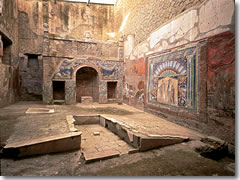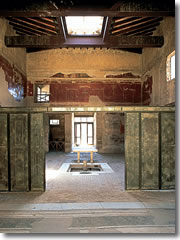- Places
- Plans
- Itineraries
- Experiences

The mosaics of Amphitrite at the House of the Neptune. Pompeii gets all the press, but Herculaneum is just as enthralling. Unlike workaday Pompeii, this ancient Roman city was a resort and retirement town for the rich—the ancient equivalent of Sorrento or Positano to Pompeii's Naples—scenically set on the shore under the menacing bulk of Vesuvius.
Herculaneum suffered serious damage in the earthquake of AD 63, and was still rebuilding when the big one hit.
In AD 79 Vesuvius blew its lid in the most famous eruption in human history, and Herculaneum was buried in a tidal wave of liquid mud that came thundering down the mountain to envelope the city with up to 82 feet of burning mud, sand, and rocks.
This muddy slurry quickly hardened to a rocky mass much more difficult to excavate than the light pumice and ash that covered the nearby city of Pompeii in the same eruption. This led to a relative delay in Herculaneum's rediscovery—they first stumbled across its theater in 1709 while digging a well, and large-scale excavations didn't start until 1927—which allowed Pompeii to gain the international fame and hog the tourism limelight.
For a long time, scholars believed that most of Herculaneum's inhabitants—unlike those in Pompeii—had time to escape, since only six bodies were found in the streets and houses (this compared to the 2,000 found at Pompeii).
Then in 1982, while excavating around the docks at what was the shoreline in ancient times, a worker discovered hundreds upon hundreds of bodies, scorched by volcanic gasses right down to the bone, huddled in the dock houses.
They had died waiting for the boats to carry them to safety.
The archaeological site is considerably smaller than that of Pompeii—Herculaneum was around 1/3 the size, with about 5,000 inhabitants to Pompeii's 20,000—but the houses belonged to the wealthy and were much more elaborate, extensive and sumptuously decorated—and rather more intact. Many still have their second stories and preserve floor mosaics, wall frescoes, ceiling stuccoes, and even wooden furnishings. Plenty of plebeian houses are mixed in as well, along with shops like the bakery with its stone grain grinders set up in the backyard.
Be sure you hit the House of the Mosaic Atrium, with an undulating checkerboard mosaic on the floor of the atrium and mythological scenes frescoed in rooms overlooking the garden.
The House of Latticework is the best example of a much cheaper, lower-class form of Roman building—this may have been a military barracks—using wooden laths filled in with tufa stones and plaster.

The House of the Wooden Partition at Herculaneum.The House of the Wooden Partition next door has scattered wall frescoes and a huge wooden double door preserved when it was instantly carbonized by the hot gasses (now protected by glass). The ground floor of this building contained shops, and the one at the corner (no. 10) preserves a wooden clothes press.
The Thermae (baths) are in pretty good shape, giving you an idea of the typical ancient Roman citizen experience at these public baths. After a workout in the palestra (gym), you'd continue on to the men's or women's section to dip first in the calidarium (hot tub), then the tepidarium (full of warm water), and finally into the frigidarium (a cold pool to close those pores). Many domed ceilings and stuccoes survive throughout, plus some appropriately aqueous floors mosaics of Neptune and dolphins.
The House of the Carbonized Furniture contains what it promises (an end table and a sofa). Wooden furnishings and partitions also survive in the House of the Neptune next door, along with a lovely polychrome wall mosaic of the sea god posing with Amphitrite.
One of the most famous villas here is the grandiose House of the Stags, named for the two marble stags being swarmed by hunting dogs in one room. This house has it all: frescoes, bits of colorful, intricate mosaics, and two more marble statues—a satyr hauling a wineskin on its shoulder and a seriously inebriated Hercules in the process of relieving himself.
Herculaneum (Ercolano Scavi)
tel. 081-857-5347 or 081-739-0963
www.pompeiisites.org
or
www.coopculture.it
€11
Open daily Apr–Oct 8:30am to 7:30pm, Nov–Mar 8:30am–5pm; last entry 90 minutes before closing
Admission to each costs €11 and is good for only one day, but you can also buy a combined ticket for both (plus three other ancient sites in the area) for €20 that's valid for three days.
Though not quite as bad as at Pompeii, it's hard to escape the baking sun in this open site, and there is dust everywhere.
Take the Circumvesuviana train from Naples or Sorrento to the "Ercolano-Scavi" stop (17 min. from Naples; 43 min. from Sorrento). » more
Share this page
Search ReidsItaly.com
Herculaneum (Ercolano Scavi)
tel. 081-857-5347 or 081-739-0963
www.pompeiisites.org
or
www.coopculture.it
€11
Open daily Apr–Oct 8:30am to 7:30pm, Nov–Mar 8:30am–5pm; last entry 90 minutes before closing